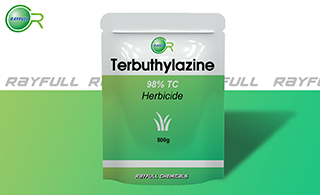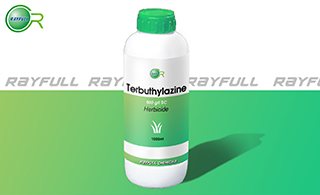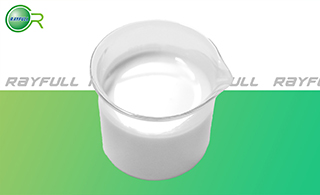Terbuthylazine
    МШ¶ЎҪт МШ¶ЎҪт
Introduction: Terbuthylazine is a selective herbicide. Chemically, it is a chlorotriazine; compared with atrazine and simazine, it has a tert-butyl group in place of the isopropyl and ethyl groups, respectively.
Common name: Terbuthylazine
Another name: Terbutylazine; Gardoprim; TERBUTYLETHYLAZINE; Terbutazine; ChlorCaragard; Primatol M; Sorgoprim; Gardeprim A 1862; Primatol-M80; Caswell No. 125B; Turbulethylazin [German]; etc.
Chemical name: N2-tert-butyl-6-chloro-N4-ethyl-1,3,5-triazine-2,4-diamine
Empirical formula: C9H16ClN5
Structural formula:

Mol. Weight: 229.71 g/mol
CAS No.: 5915-41-3
Specifications
Leading Terbuthylazine supplier
Terbuthylazine 98% TC
Terbuthylazine 500 g/L SC
Packing:
BULK PACKING
Powder: 25kg/Bag, 25kg/Drum, 50kg/Drum etc.
Liquid: 200L/Drum, 20L/Drum, 10L/Drum etc.
SMALL PACKING
Powder: 1kg/Alu bag, 500g/Alu bag, 200g/Alu bag, 100g/Alu bag, 50g/Alu bag, 15g/Alu bag etc.
Liquid: 5L/Drum, 1L/Bottle, 500ml/Bottle, 250ml/Bottle, 100ml/Bottle, 50ml/Bottle etc.
Customerized packing label
Terbuthylazine FAO standard
Professional registration
HAZARDS IDENTIFICATION
Hazard statement(s)
H302 (85.93%): Harmful if swallowed.
H332 (10.65%): Harmful if inhaled.
H400 (70.34%): Very toxic to aquatic life.
H410 (70.34%): Very toxic to aquatic life with long lasting effects.
Precautionary statement(s)
P261: Avoid breathing dust/fume/gas/mist/vapors/spray.
P264: Wash ... thoroughly after handling.
P270: Do not eat, drink or smoke when using this product.
P273: Avoid release to the environment.
P301+P312: IF SWALLOWED: call a POISON CENTER/doctor/... IF you feel unwell.
P304+P312: IF INHALED: Call a POISON CENTER/doctor/... if you feel unwell.
P304+P340: IF INHALED: Remove person to fresh air and keep comfortable for breathing.
P312: Call a POISON CENTER or doctor/... if you feel unwell.
P330: Rinse mouth.
P391: Collect spillage.
P501: Dispose of contents/container to an approved waste disposal plant.
Supplemental Hazard Statements: none.
MAMMALIAN TOXICOLOGY
Acute toxicity: 1) Acute oral LD50 for rats is >1000 a.i.mg/kg. 2) Acute dermal LD50 for rats is >2000 a.i.mg/kg. 3) Acute inhalation toxicity LC50 (4 h) for rats is >5.3 a.i.mg/L. 4) Skin irritation: Slightly irritating to skin (rabbits). 5) Eye irritation: Mildly to moderately irritating to eyes (rabbits). 6) Skin sensitization for guinea pig: Not sensitising.
NOEL: (2 y) for rats is 0.35 mg/kg/day; (2 y) for mice is 16.99 mg/kg/day. Other Not genotoxic.
ADI 0-0.004 mg/kg b.w.
Classification:
WHO Classification: III (Slightly hazardous)
EC Risk Classification: Xn - Harmful: R22
US EPA Classification (formulation): III (Caution - Slightly toxic)
ECOTOXICOLOGY
Effect on birds: Acute oral LD50 for Bobwhite quail is >1236 a.i.mg/kg. Effect on fish: Acute LC50 (96 h) for Rainbow trout is 2.2 a.i.mg/l. Effects on aquatic invertebrates: Acute EC50 (48 h) for Daphnia magna is 21.2 a.i.mg/l. Effects on algae: Acute 72 hour EC50 for Pseudokirchneriella subcapitata is 0.012 a.i.mg/l. Effects on bees: contact acute 48 hour LD50 is >32 a.i.ҰМg/bee, oral acute 48 hour LD50 is >22.6 a.i.ҰМg/bee. Effects on earthworms: Acute 14 day LC50 is >141.7 a.i.mg/kg.
ENVIRONMENTAL FATE
Animals In mammals, following oral administration, 72-84% is eliminated in the urine and faeces within 24 h, and almost all within 48 h. A de-ethyl metabolite forms rapidly, followed by conjugates of products formed by oxidation of one methyl group of the tert-butyl moiety. All are rapidly excreted. Plants Triazine-tolerant plants (e.g. maize) rapidly de-chlorinate terbuthylazine to hydroxy-terbuthylazine. Various amounts of de-ethylated and hydroxy de-ethylated metabolites are produced, depending on the plant species. Soil/Environment Adsorption on soils is strong: Koc 162-278, Kd 2.2-25 are typical values for light agricultural soils. Terbuthylazine is only slightly mobile. Microbial degradation proceeds mainly by de-ethylation and hydroxylation, with eventual ring cleavage. DT50 30-60 d in biologically active soil.
Usage: Terbuthylazine was introduced by J. R. Geigy S.A. (now Syngenta AG). It is a herbicide to control grass and broad-leaved weeds in a variety of situations including forestry and for control slime-forming algae, fungi, and bacteria in non-agricultural situations.
Application: Biochemistry Photosynthetic electron transport inhibitor at the photosystem II receptor site. Maize tolerance of triazines is attributed to conjugation with glutathione. Mode of action Herbicide, absorbed mainly by the roots. Uses Broad-spectrum pre- or post-emergence weed control in maize, sorghum, vines, fruit trees, citrus, coffee, oil palm, cocoa, olives, potatoes, peas, beans, sugar cane, rubber, and in forestry in tree nurseries and new plantings. It remains largely in the topsoil, controlling a wide range of weeds, at rates of 0.6-3 kg/ha; high rates are only recommended as band applications. In Europe, used mainly on maize and sorghum with a maximum application rate of 1.5 kg/ha, mainly in mixture with other herbicides. Phytotoxicity Phytotoxic to many annual plants and to aquatic plants.
| 






